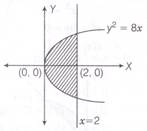Ask questions which are clear, concise and easy to understand.
Ask QuestionPosted by Harshit Tyagi 6 years, 6 months ago
- 0 answers
Posted by Aastha Singh 6 years, 6 months ago
- 2 answers
Vaitheeshwaran Raghu 6 years, 6 months ago
Posted by Kiran Shukla 6 years, 6 months ago
- 2 answers
Posted by Vivek Kumar 6 years, 6 months ago
- 1 answers
Posted by Smruti Panda 6 years, 6 months ago
- 1 answers
Abhinav Singh 6 years, 6 months ago
Posted by Harsh Kumar 6 years, 6 months ago
- 0 answers
Posted by Harsh Chauhan 6 years, 6 months ago
- 1 answers
Sia ? 6 years, 6 months ago
Let f(x) = y. Then,
{tex}\frac{{3x - 4}}{5} = y{/tex}
{tex}\; \Rightarrow x = \frac{{5y + 4}}{3}{/tex}
{tex} \Rightarrow {f^{ - 1}}(y) = \frac{{5y + 4}}{3}{/tex}
Posted by Aditya Verma 6 years, 6 months ago
- 2 answers
Posted by Teja Teja 6 years, 6 months ago
- 2 answers
Posted by Pandit Ankit 6 years, 6 months ago
- 2 answers
Sia ? 6 years, 6 months ago
NCERT Exemplars are basically practice-books that include extra questions of a higher level and are meant for aiding in-depth learning. They are used especially for JEE mains and JEE advanced exams. The NCERT exemplar books contain conceptual sums, which cover CBSE board exams and competitive exams (JEE main and JEE advanced). CBSE board exams sometimes contain in-depth sums. So, it is beneficial if you go through these books.
Omkar Pawar 6 years, 6 months ago
Posted by Simran Srikoti 6 years, 6 months ago
- 1 answers
Shalini Sharma 6 years, 6 months ago
Posted by Pratibha Gupta 6 years, 6 months ago
- 1 answers
Sia ? 6 years, 6 months ago
The second derivative tells us a lot about the qualitative behaviour of the graph. If the second derivative is positive at a point, the graph is concave up. If the second derivative is positive at a critical point, then the critical point is a local minimum. The second derivative will be zero at an inflection point.
In physics, jerk is the rate of change of acceleration; that is, the time derivative of acceleration, and as such the second derivative of velocity, or the third time derivative of position.
Posted by Aman Kumar 6 years, 6 months ago
- 5 answers
Avinash Pateriya 6 years, 6 months ago
Aman Kumar 6 years, 6 months ago
Posted by Avishek Gope 6 years, 6 months ago
- 0 answers
Posted by Rajni 420 6 years, 6 months ago
- 1 answers
Posted by Akash Maurya 6 years, 6 months ago
- 1 answers
Posted by Raj Kushwaha 6 years, 6 months ago
- 0 answers
Posted by Shivam Kumar 6 years, 6 months ago
- 0 answers
Posted by Gagan Sahni 6 years, 6 months ago
- 0 answers
Posted by Thakur Das 6 years, 6 months ago
- 1 answers
Sia ? 6 years, 6 months ago
Check last year papers here : <a href="https://mycbseguide.com/cbse-question-papers.html">https://mycbseguide.com/cbse-question-papers.html</a>
Posted by Nitesh K 6 years, 6 months ago
- 0 answers
Posted by Anamika Rajput 6 years, 6 months ago
- 0 answers
Posted by Sahil Garg 6 years, 6 months ago
- 1 answers
Posted by Parteek Gurjar 6 years, 6 months ago
- 2 answers
Posted by Vivek Kumar 6 years, 6 months ago
- 1 answers
Subrata Debnath 6 years, 6 months ago
Posted by Kamlesh Kumar 6 years, 6 months ago
- 4 answers
Posted by Abhishek Yadav 6 years, 6 months ago
- 1 answers
Sia ? 6 years, 6 months ago
We have, y2 = 8x and x = 2

{tex}\therefore{/tex} Area of shaded region, {tex}A = 2\int_0^2 {\sqrt {8x} dx = 2.2\sqrt 2 \int_0^2 {{x^{1/2}}dx} } {/tex}
{tex}= 4.\sqrt 2 .\left[ {2.\frac{{{x^{3/2}}}}{3}} \right]_0^2 = 4\sqrt 2 \left[ {\frac{2}{3}.2\sqrt 2 - 0} \right]{/tex}
{tex}= \frac{{32}}{2}{/tex} sq units

myCBSEguide
Trusted by 1 Crore+ Students

Test Generator
Create papers online. It's FREE.

CUET Mock Tests
75,000+ questions to practice only on myCBSEguide app
 myCBSEguide
myCBSEguide